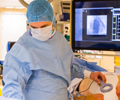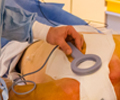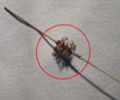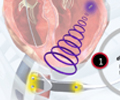
October 2018
Paul Foley
Abstract

This supplement is published to mark 60 years of cardiac pacing, with a particular focus on the history and developments of pacing in the UK. We approached most manufacturers of devices and several pharmaceutical companies to help sponsor the publication. We are therefore indebted for the sponsorship from Novartis Pharmaceuticals UK, Biotronik UK and Medtronic....
|
View

October 2018 Br J Cardiol 2018;25(suppl 3):S4–S7
Paul Foley
Abstract

Cardiac pacing is 60 years old and is in continuous development. In this article, I review current pacing practice aimed at improving training by using surgical techniques, developments in remote follow-up, and changes in practice in patients receiving implantable defibrillators and cardiac resynchronisation therapy. Direct His-bundle pacing, which is now feasible using specially designed guide catheters and a standard pacing lead, appears to have significant benefits with reductions in heart failure hospitalisation, atrial fibrillation and mortality....
|
View

October 2018 Br J Cardiol 2018;25(suppl 3):S7–S10
Richard Sutton
Abstract

This paper reviews some of the early experiences and difficulties of pacing (a field in its infancy at the time) at St. George’s Hospital, London, in the 1960s and 70s. Without the pioneering work from that time, and the sharing of knowledge, the subsequent progress that has been made, and the devices and modern information available to us, would not have been possible....
|
View

October 2018 Br J Cardiol 2018;25(suppl 3):S12–S19
Francisco Leyva
Abstract

Cardiac resynchronisation therapy (CRT) is a very effective treatment for selected patients with severe and mild heart failure (HF), impaired left ventricular (LV) function and a wide QRS complex. Findings from randomised clinical trials (RCTs) and numerous observational studies have provided insights as to which patients benefit the most. Technological advances, such as the quadripolar lead and LV endocardial systems have made CRT more effective and more widely available. While indications for CRT are unlikely to change in the foreseeable future, this review discusses how developments over the next 10 years may see progress with leadless CRT systems, perhaps in combination with a subcutaneous device....
|
View

October 2018 Br J Cardiol 2018;25(suppl 3):S20–S24
Balrik Singh Kailey, Christopher Allen, Badrinathan Chandrasekaran
Abstract

Cardiac device therapy has changed the landscape of heart failure management in the past decade in patients with heart failure and reduced left ventricular ejection fraction (HFREF). This has shifted some of the focus away from pharmacotherapy. This review will highlight the importance and clinical benefit of first ‘optimising’ medical therapy by introducing new, proven medications, as opposed to accepting the standard pharmacological therapy, and then analyse how treatment regimens can be further refined after device insertion. Finally, we will discuss how pharmacotherapy may be used as an avenue to reduce the proportion of patients that do not respond to device therapy....
|
View

October 2018 Br J Cardiol 2018;25(suppl 3):S25–S29
Daniel Keene, Matthew Shun-Shin, Ahran Arnold, Zachary Whinnett
Abstract

Permanent His-bundle pacing promises to be a major advance in the field of cardiac rhythm management. It allows ventricular stimulation to occur via the hearts’ intrinsic conduction system and, therefore, provides physiological pacing. By positioning a lead on the bundle of His, typically at a site within the right atrium, the His-Purkinje system can be activated to produce rapid and synchronous ventricular activation. There is now a growing body of data, albeit mainly observational, demonstrating the feasibility and safety of chronic His pacing. If the benefits of true physiological activation are mirrored by randomised trials, His-bundle pacing will change the landscape of cardiac pacing....
|
View

October 2018 Br J Cardiol 2018;25(suppl 3):S35–S39
Osman Najam, Hitesh C Patel, Manav Sohal, Mark M Gallagher
Abstract

Transvenous lead extraction is the gold standard for cardiovascular implantable electronic device lead removal. Increasing rates of device implantation have led to an increased number of extractions being performed. Over the last decade, improvements in techniques have rendered it a safe and effective procedure, if performed by an experienced procedural team. With new guidance published by the Heart Rhythm Society, we present a timely review of the techniques currently used....
|
View

October 2018 Br J Cardiol 2018;25(suppl 3):S30–S34
Paul Roberts
Abstract

Conventional lead-based pacing has developed over 60 years, but is associated with complications related to the generator and leads. Leadless pacing has evolved over the last four years, with the evidence base demonstrating reason to be optimistic, with comparable or low complication rates....
|
View

October 2018 Br J Cardiol 2018;25(suppl 3):S40–S43
John Morgan
Abstract

Remote monitoring embraces data collection, data analysis, clinical decision-making and an effector arm that provides therapy instructions to the patient, or their carer or a near-to-patient healthcare professional. Disease-specific monitoring technologies are increasingly available. The design and implementation of appropriate care pathways is critical to the success of remote monitoring, as data acquisition alone is of no inherent value without an appropriate and timely response. A further key element affecting widespread adoption of remote monitoring is reimbursement, which is highly variable. It is, as yet, an unproven assumption that remote monitoring can reduce healthcare costs. These issues are critically discussed....
|
View

October 2018 Br J Cardiol 2018;25(suppl 3):S44–S45
Matthew Swift
Abstract

The advancement of remote or mobile technologies over the last 15 years has changed our lives beyond all comprehension. The evolution of the remote monitoring of cardiovascular implantable electronic devices (CIEDs), in particular, has seen a paradigm shift in technology, from the original analogue phone remote monitors with their induction loop headers, to the radio frequency (RF) devices we often see in use today. This short review charts the experience with remote CIED monitoring in a district general hospital, and focuses on the role and work patterns of cardiac physiologists in service provision....
|
View











